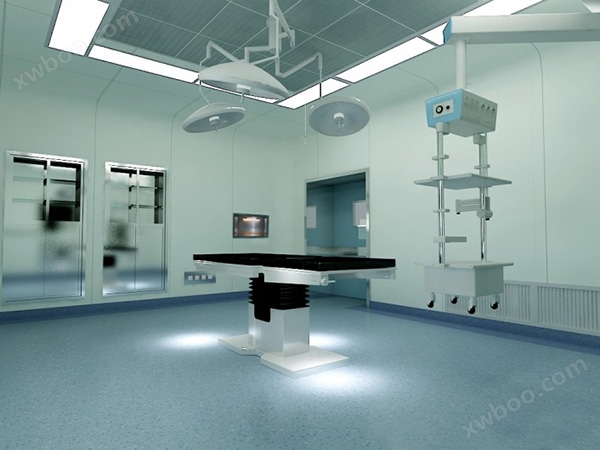The hospital medical industry is a very large and special industry, especially the hospital operating room has high requirements for air cleanliness. Typically, qualified hospital operating room purification projects or medical cleanrooms require a minimum of 30% efficiency pre filters and 90% efficiency sub high efficiency filters to filter hospital air. In general, high-efficiency filters are not required for filtration, but in special circumstances such as isolation rooms, specific testing and care areas, high-efficiency filters are needed for filtration.
Reference for categories and levels of clean operating rooms:
Name of hospital operating room |
category |
cleanliness |
Special sterile purification operating room |
Ⅰ |
Level 100 (local laminar flow) |
Aseptic operating room |
Ⅱ |
1000-10000 levels |
General operating room |
Ⅲ |
100000 level |
Bacterial operating room |
Ⅳ |
Generally no requirements or>100000 level |
Toxic operating room |
Ⅴ |
No requirements |
Surgical auxiliary area |
Ⅲ |
100000 level |
Other rooms |
|
100000 to 1000000 levels |
The clean room of the hospital system was first used in the operating room, which is now known as the hospital operating room purification project. At first, it was only widely used in orthopedic surgery because orthopedic surgery takes a long time and is prone to infection. The ideal level of control is to achieve a cleanliness level of 100 in the air near the operating table. It is generally recommended to use a top efficient air filtration system, which can cover an area of at least 3m x 3m, including the operating table and people.
Other areas where medical cleanrooms have been applied include delivery rooms, daycare rooms, burn rooms, and cardiac patient care units. One of the latest developments is the application of clean rooms in dental surgery, which reduces the risk of infection among medical staff during long-term surgical procedures.
As one of the important functional zones in hospitals, the engineering quality of cleanrooms directly affects the use of the hospital and the treatment of patients. To improve the engineering quality of hospital cleanrooms, it is necessary to pay attention to design, construction, and maintenance simultaneously.
The most widely used clean operating room in hospitals is a modern operating room that uses air purification technology to replace traditional methods such as ultraviolet radiation for pollution control throughout the entire process. In a clean operating room, the infection rate of patients can be reduced by more than 10 times, thereby reducing or eliminating the use of antibiotics that can harm the patient's immune system. The characteristic of a clean operating room is to be both dust-free and sterile.
Hospital cleanrooms include operating rooms, obstetrics, infant and toddler wards (NICUs), intensive care units (ICUs), burn wards and dissection rooms, purification laboratories, artificial dialysis rooms, specimen rooms, etc. The engineering quality and medical quality have a direct and important relationship.
1、 Design
The "Code for Construction and Acceptance of Cleanrooms" in China emphasizes that fresh air must follow the principle of three-level filtration. This is because compared with the air conditioning system, the dust concentration load ratio of the fresh air in the purification system is over 90%. Therefore, in order to ensure the quality of operation, it is necessary to emphasize the three-stage filtration of the fresh air. This has now been included as a regulation in the standards and specifications for clean operating departments in hospitals. In addition, the return air must have a filter, and it is best to have a medium efficiency. Only by accurately understanding the requirements of the "standards" can designers make the cleanroom meet the functional requirements of the hospital to the greatest extent possible.
Designers must ensure the quality of the cleanroom project and conduct careful research and inspection of the hospital cleanroom construction site. Otherwise, the quality of the designed cleanroom project will be greatly compromised. When conducting dust concentration testing in a hospital's cleanroom, it was suddenly discovered that the dust concentration had risen sharply and exceeded the standard severely. The first thing that the engineering personnel thought of was the leakage of the filter air outlet. After inspection, although it was found that there was indeed leakage, it did not match the amount of dust concentration detected. Based on experience, this is due to improper design of the new air outlet. As the new air outlet is located on the top of the 5th floor, there is a garbage station below it, which has a habit of regularly burning garbage. A large amount of thick dust comes from the thick smoke emitted from below the new air outlet. Such a new air outlet position will inevitably result in endangering indoor cleanliness. Regardless of the quality of the later construction, it is difficult for the engineering quality of the clean room to meet the requirements. In fact, this is contrary to the overall requirement in the "regulations" that newly built clean operating rooms should be far away from pollution sources.
Design is the foundation of clean room engineering quality, and the design of hospital operating room purification engineering is never done in isolation. It requires continuous problem-solving to meet the quality requirements of clean room engineering. Therefore, design is the first guarantee of clean room engineering quality.


